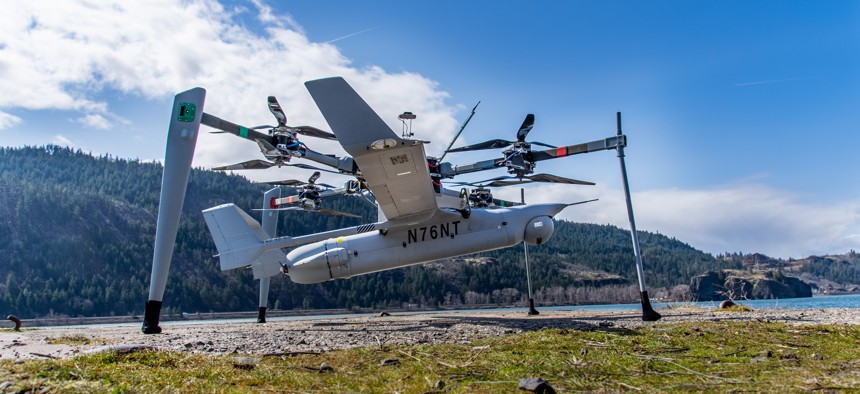
Insitu's Flying Launch and Recovery System is a quadcopter that launches and helps recover the company's Integrator drone. Insitu
Insitu’s New Shipboard Drone Launches and Catches Other Drones
The FLARS quadcopter nabs larger fixed-wing Integrators in flight and lowers them to the deck.
Space is always tight aboard a warship, so drone-maker Insitu has developed a smaller alternative to the trailer-sized slingshot and tower that currently launch and recover its Integrator drones. This week, the Boeing subsidiary took the wraps off its Flying Launch and Recovery System, or FLARS: a drone that launches and catches other drones.
“In this case, we think and truly believe that this is going to offer a better performance and in high seas or high ship motion,” said Justin Pearce, Insitu vice president of engineering.
[INSERT VIDEO HERE]
Here’s how it works. The FLARS quadcopter carries the 265-pound Integrator to an altitude between 300 and 500 feet, gathers airspeed, and releases the fixed-wing drone in midair. While the Integrator carries out its mission—it can stay aloft for some 16 hours—the quadcopter returns to the ship.
When the Integrator returns, FLARS takes off to meet it. This time, it’s carrying a recovery cable attached to the ship’s deck, a job currently performed by a small crane. The Integrator flies into and locks onto the cable and is then lowered onto the deck.
In response to a Navy request, the company demonstrated the technology last year aboard the USS Paul Hamilton, an Arleigh Burke-class guided-missile destroyer. Details of the test and video were released for the first time this week.
L3Harris Technologies also demonstrated “multiple technologies designed to operate as a portable system in challenging conditions while providing the same wide-area coverage as a shore-based system,” the Navy said in a statement.
Today, about 300 Integrator drones are flown by the U.S. Navy, Marine Corps, and allied militaries. The multi-mission can carry a wide array of payloads, including signals-intelligence or electronic-warfare gear and a synthetic aperture radar.
Insitu expects to sell the FLARS system to current and new Integrator users who are pressed for physical space.
“What we see going forward is, this is going to be a standard piece of kit that folks can add to their current Integrators if they need to be more expeditionary and mobile,” Pearce said. “We think folks will be buying Integrator VTOL as a full-up system as well.”
The company is also working to add satellite communications to Integrator, allowing it to fly several hundred miles from a ship. They’re also working to add more “flexible connectivity” to their drones.
“We see ourselves more connected in the future within our customers' networks, such that they can do kind of novel things,” Pearce said. “We're [also] focused on having an architecture that readily accepts anybody's capability for autonomy.”
This would allow a single person to operate multiple drones.





